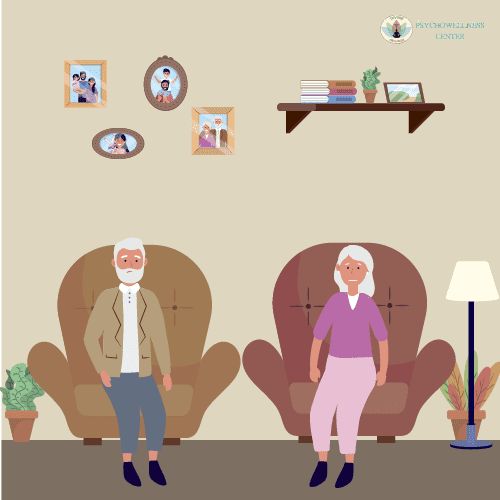Isolation Among the Geriatric Population

Isolation among the geriatric population is a pervasive issue with significant implications for mental, emotional, and physical health. As individuals age, their social networks often diminish due to factors such as retirement, mobility limitations, and the loss of loved ones. This diminishing social interaction can lead to a cascade of negative effects, exacerbating conditions such as depression, anxiety, and stress, and contributing to other health challenges. In this blog, we explore the profound impact of isolation on older adults and discuss various interventions and support mechanisms aimed at mitigating its effects.
The Impact of Isolation
One of the most pronounced consequences of isolation among older adults is its association with mental health disorders such as depression, anxiety, and stress. Research indicates that social isolation and loneliness are significant risk factors for the onset and exacerbation of these conditions. When individuals lack regular social interactions, they may experience feelings of loneliness, sadness, and hopelessness, which can intensify over time without intervention.
As individuals age, they are more likely to experience the loss of friends, spouses, or family members. These losses can profoundly impact their social networks and contribute to increased isolation. Grieving older adults may withdraw from social activities and interactions, further exacerbating their sense of loneliness and isolation.
Social isolation can also make older adults more vulnerable to abuse and neglect. Without regular social contact, instances of mistreatment can go unnoticed for extended periods, leading to physical and emotional harm. Addressing isolation can therefore be critical in safeguarding the well-being of older adults and preventing instances of elder abuse.
The relationship between isolation and sleep disturbances among older adults is well-established. Lack of social engagement and loneliness can disrupt sleep patterns, leading to insomnia, fragmented sleep, or other sleep-related issues. Sleep problems, in turn, can exacerbate existing health conditions and contribute to a decline in overall well-being.
Interventions and Support
- Cognitive Behavioral Therapy (CBT) and Mindfulness: Cognitive Behavioral Therapy (CBT) has shown promise in treating depression and anxiety among older adults by addressing negative thought patterns and promoting adaptive coping strategies (Gould et al., 2012). Similarly, mindfulness-based interventions have been effective in reducing stress and enhancing emotional resilience among seniors (Galante et al., 2018). These therapeutic approaches emphasize the importance of addressing underlying psychological factors associated with isolation and loneliness.
- Physical Health: Isolation not only affects mental health but also has implications for physical well-being. Socially isolated older adults are at increased risk of developing chronic conditions such as cardiovascular disease, hypertension, and cognitive decline. Encouraging physical activity, promoting healthy lifestyles, and ensuring regular medical check-ups can help mitigate these risks and support overall health in older adults.
- Counseling and Virtual Support: The advent of technology has expanded access to mental health services for older adults through in-clinic counseling and virtual support groups. These platforms provide seniors with opportunities to connect with peers, participate in group discussions, and access professional guidance from the comfort and convenience of their homes. Interventions can help reduce barriers to care and enhance social engagement among isolated older adults.
- Community Engagement Programs: Community-based initiatives play a crucial role in combating isolation among older adults. Programs that offer social activities, volunteer opportunities, and intergenerational exchanges can foster a sense of belonging and connection within local communities (Cohen-Mansfield & Perach, 2015). These initiatives provide older adults with opportunities to build meaningful relationships, engage in fulfilling activities, and contribute to their communities.
- Family and Caregiver Support: Family members and caregivers play a vital role in supporting older adults who may be experiencing isolation. Regular visits, phone calls, and involvement in decision-making processes can provide emotional support and reassurance to seniors (Pinquart & Sörensen, 2011). Caregivers can also help facilitate social interactions, coordinate medical care, and advocate for the needs of older adults within their social networks.
- Creating Age-Friendly Environments: Designing age-friendly environments in residential settings and public spaces can promote social inclusion and accessibility for older adults. Features such as accessible transportation, community centres, and recreational facilities can facilitate social interactions and engagement (World Health Organization, 2007). Age-friendly initiatives aim to create supportive environments that enhance the quality of life for older adults and promote active aging.
Conclusion
Isolation among the geriatric population is a complex issue with far-reaching consequences for mental health, emotional well-being, and physical health. Addressing isolation requires a multifaceted approach that integrates psychological interventions, community support, and technological innovations. By promoting social engagement, enhancing mental health services, and creating age-friendly environments, we can empower older adults to lead fulfilling and connected lives.
Psychowellness Center offers top-tier mental health services across Vasant Vihar, Faridabad, and NOIDA, making expert care accessible to clients throughout Delhi NCR.
Contribution: For expert mental health support, connect with Dr. R K Suri, a leading clinical psychologist, and Ms. Gurleen Kaur, a renowned counseling psychologist and life coach, on TalktoAngel.
References:
- Cacioppo, J. T., Hawkley, L. C., Norman, G. J., & Berntson, G. G. (2011). Social isolation. Annals of the New York Academy of Sciences, 1231(1), 17-22.
- Cohen-Mansfield, J., & Perach, R. (2015). Interventions for alleviating loneliness among older persons: A critical review. American Journal of Health Promotion, 29(3), e109-e125.
- Gould, R. L., Coulson, M. C., Howard, R. J., CBT for late-life depression: A review, 2012. Journal of Affective Disorders, 139(1), 1-12.
- Shankar, A., McMunn, A., Banks, J., & Steptoe, A. (2011). Loneliness, social isolation, and behavioral and biological health indicators in older adults. Health Psychology, 30(4), 377-385.




SHARE